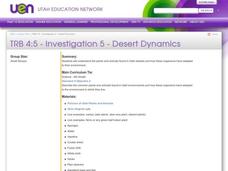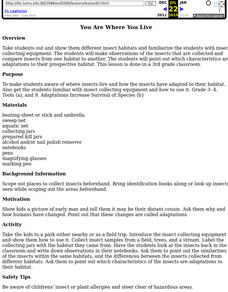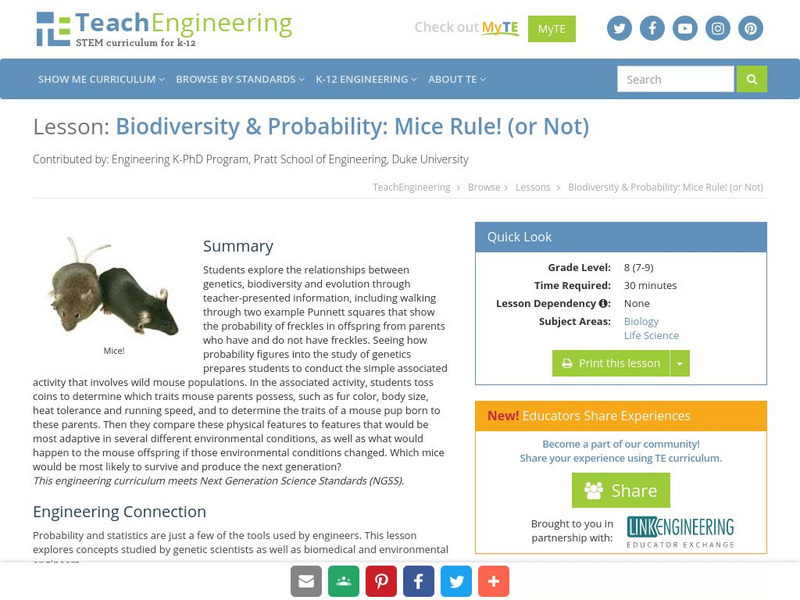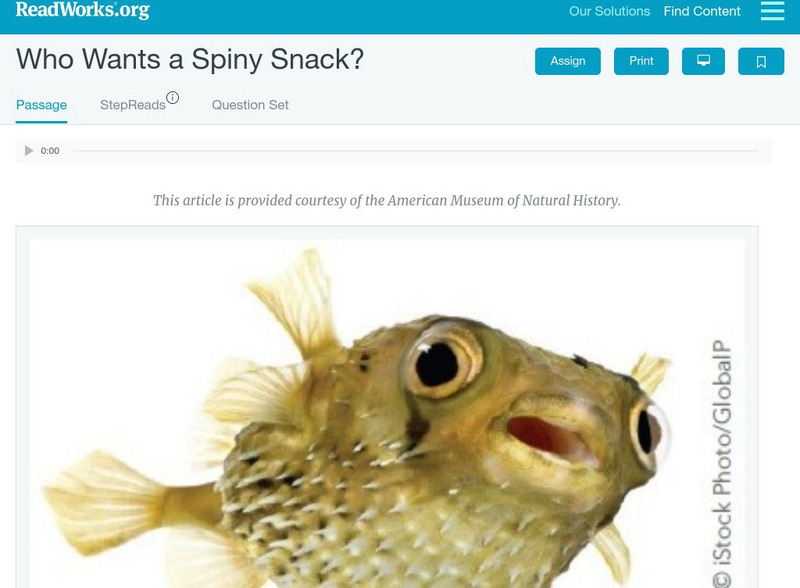Curated OER
Mother Nature's Laboratory
Students research how various plants and animals adapt over time to specific habitats and for specific purposes. Students produce a pictorial report on an example of an animal or plant's adaptation.
Curated OER
Something Fishy
Learners synthesize what they have learned about the anatomy of fish and their methods of adapting to survive.
Curated OER
Adaptation Scavenger Hunt
Fourth graders recognize the specific adaptations of living things and relate them to survival within the animals environment. They study common plants and animals found in Utah environments and how they have adapted to the environment...
Curated OER
Desert Dynamics
Students investigate the plants and animals found in Utah deserts and how these organisms have adapted to their environment. They brainstorm ways that desert plants are different from or similar to wetland plants.
Curated OER
Learning Activities: What Color Am I?
Learners identify various species of anurans by their skin coloration. They describe how coloration contributes to survival.
Curated OER
You Are Where You Live
Students explore where insects live and how they have adapted to their environment.
Curated OER
Why Don't Whales Have Legs?
Students are given a variety of materials and are asked to design a heat loss experiment that results in a reasonable explanation of "Why don't whales have legs?" students work with the theory of natural selection.
TED Talks
Ted: Ted Ed: Five Fingers of Evolution
Video discusses the concept of evolution and the five processes that can cause it to happen. [5:24] Includes a brief quiz and a list of additional resources to explore.
TED Talks
Ted: Ted Ed: How Life Came to Land
This video explores arthropods, who first made the transition from water to land and who outnumber all terrestrial animals. [5:28] Followed by a short quiz and a list of additional resources to explore.
TED Talks
Ted: Ted Ed: Symbiosis: A Surprising Tale of Species Cooperation
Video explores the interdependence of two species to define the concept of symbiosis. [2:23] Followed by a short quiz and a list of additional resources to explore.
Science Buddies
Science Buddies: Can You Predict a Bird's Lifestyle Based on Its Feet?
Animals have special features that allow them to adapt to conditions in certain environments. You might not be able to dive down 3281 feet to observe the deep sea anglerfish, but in this science fair project you can discover what the...
PBS
Pbs Learning Media: Mimicry: The Orchid and the Bee
In this photograph from Oxford Scientific Films, a horned bee attempts to mate with an Ophrys orchid, which has evolved to resemble a female bee.
Encyclopedia of Earth
Encyclopedia of Earth: Evolutionary Biology: Extremophile
Article describing some of the extreme environments where extremophile organisms can live, and giving examples from bacteria, archaea, flora, and fauna. (Published: November 26, 2010)
Encyclopedia of Earth
Encyclopedia of Earth: Adaptations of Desert Amphibians and Reptiles
The evolution of amphibians from prehistoric days is described, and the challenges they face when living in a desert environment, of which the ability to reproduce is the greatest. How they manage to survive in a desert is explained in...
Other
Blackwell Publishing: Evolution: Adaptive Explanation
These pages are part of a site called Evolution that accompany a textbook by the same name. Mark Ridley is the author. There is a large amount of information available about adaptations and their role in evolution.
Other
Simple Science: Hand It to the Animals
The innovative resource has young scholars examine X-ray images of the ?hands? of different animals and then determine the function of each hand from its form. The activity has an interactive online version and a printable data sheet.
National Geographic
National Geographic: Adapting Under Pressure
Students learn about James Cameron's Challenger Deep dive and about the marine animals that live in different layers of the ocean. They then study the characteristics of the hadalpelagic zone at the bottom of the ocean, and imagine and...
National Geographic
National Geographic: Adaptations: Changes Through Time
People, plants, and animals make minor adaptations all of the time. This lesson will idenitfy why adaptations are critical for survival by diving into pterosaurs.
CK-12 Foundation
Ck 12: Episd: Evolution of Life
[Free Registration/Login may be required to access all resource tools.] Meet Charles Darwin and his theory of evolution and natural selection. Understand why adaptations are important.
BBC
Bbc Newsround: How Cuttlefish Avoid Being Eaten by Sharks
Brief read on an adaptation technique cuttlefish use to avoid being eaten by sharks.
Georgia Department of Education
Ga Virtual Learning: Biology: Evolution
Through informational text, online lab activities, virtual simulations, and video clips, students study the concepts of biological evolution.
Georgia Department of Education
Ga Virtual Learning: Marine Vertebrates
Learn about vertebrates found in the ocean, their individual methods of adaptations, identifying characteristics and contributions to the marine ecosystem.
TeachEngineering
Teach Engineering: Mice Rule! (Or Not)
Students explore the relationships between genetics, biodiversity, and evolution through a simple activity involving hypothetical wild mouse populations. First, students toss coins to determine what traits a set of mouse parents...
Read Works
Read Works: Passages: "Who Wants a Spiny Snack?"
[Free Registration/Login Required] The passage "Who Wants a Spiny Snack?" focuses on the Pufferfish and how it has adapted to protect itself from predators in the ocean. A comprehension question set with answer key is provided. A Step...






















